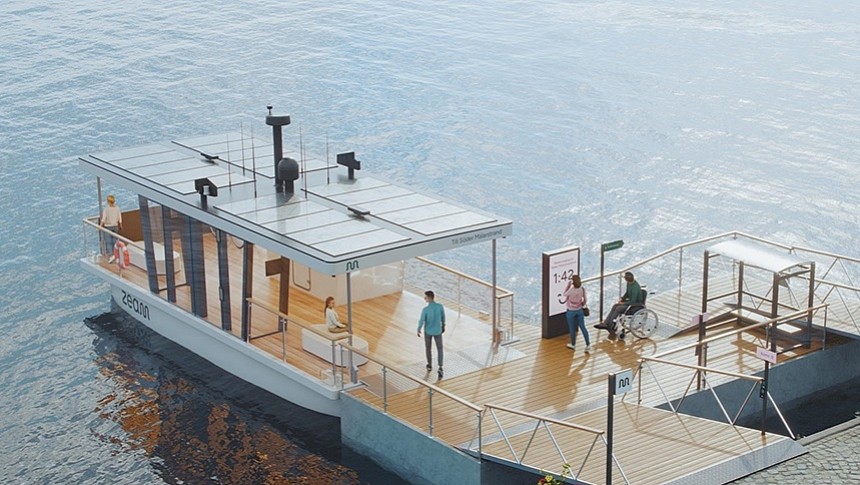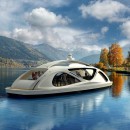As technology evolves, urban transportation goes through important changes, both on land and on water. The advent of autonomous vehicles marks a significant milestone in the history of urban mobility, and they are bound to transform the way we commute in the years to come.
Since urban waterways are just as important as roads in water-sensitive cities, self-driving technologies are not limited to dry land anymore, as tech companies across the globe have been exploring ways to remove the need for crews in vessels destined for commercial operation.
Norwegian technology provider Zeabuz has created the world's first self-sailing electric ferry, called Zeam (Zero Emission Autonomous Mobility), which is expected to begin operation in Stockholm in the following months. The company initially presented a prototype for a driverless and electric watercraft in 2020, and the design has now been turned into reality.
The electric multihull will be built by Brodrene Aa, and Norwegian shipping company Torghatten will operate the zero-emission passenger ferry between the Stockholm islands of Kungsholmen and Sodermalm.
"Many large cities around the world have problems with congestion, lack of capacity, and environmental and air pollution. Self-driving technology will be part of the solution and will be good for both the climate and people," commented Reidun Svarva, Chief Business Development Officer at Torghatten. "Stockholm’s unique water environment makes the city perfect for being the first to launch the technology."
The Norwegian University of Science and Technology (NTNU) in Trondheim is where the idea of self-driving city ferries is rooted. In 2017, a team of researchers at NTNU created the initial prototype called MilliAmpere. The startup Zeabuz, of which Torghatten is a co-owner, was later founded with the aim of commercializing the technology and reducing traffic congestion in cities with waterways.
According to Torghatten and Zeabuz, the 39-foot-long (12-meter) autonomous ferry is equipped with an electric motor and a 188 kWh Zem battery bank. Rooftop-mounted solar panels will take care of producing clean energy to recharge the battery pack.
Though Torghatten guarantees that the self-driving boat technology is tested and safe, at first, the ferry will still have an operator on board to ensure everything runs smoothly. The AI-based technology on board the watercraft will use radar and LiDAR to operate, as well as infrared and cameras to detect objects on the water. Ultrasonic sensors and GPS will help with docking maneuvers and positioning.
The autonomous ferry will run every 15 minutes for a total of 15 hours per day. As such, the vessel's batteries can also be recharged overnight. It will be able to carry 24 passengers, as well as bicycles.
While the Zeam ferry will start operating in Stockholm net month, there are plans to expand the concept to other parts of the world as well. Paris might be the next big city to adopt such technology, as it is said to intend to use it on the Seine for the upcoming 2024 Olympics.
Norwegian technology provider Zeabuz has created the world's first self-sailing electric ferry, called Zeam (Zero Emission Autonomous Mobility), which is expected to begin operation in Stockholm in the following months. The company initially presented a prototype for a driverless and electric watercraft in 2020, and the design has now been turned into reality.
The electric multihull will be built by Brodrene Aa, and Norwegian shipping company Torghatten will operate the zero-emission passenger ferry between the Stockholm islands of Kungsholmen and Sodermalm.
"Many large cities around the world have problems with congestion, lack of capacity, and environmental and air pollution. Self-driving technology will be part of the solution and will be good for both the climate and people," commented Reidun Svarva, Chief Business Development Officer at Torghatten. "Stockholm’s unique water environment makes the city perfect for being the first to launch the technology."
The Norwegian University of Science and Technology (NTNU) in Trondheim is where the idea of self-driving city ferries is rooted. In 2017, a team of researchers at NTNU created the initial prototype called MilliAmpere. The startup Zeabuz, of which Torghatten is a co-owner, was later founded with the aim of commercializing the technology and reducing traffic congestion in cities with waterways.
According to Torghatten and Zeabuz, the 39-foot-long (12-meter) autonomous ferry is equipped with an electric motor and a 188 kWh Zem battery bank. Rooftop-mounted solar panels will take care of producing clean energy to recharge the battery pack.
Though Torghatten guarantees that the self-driving boat technology is tested and safe, at first, the ferry will still have an operator on board to ensure everything runs smoothly. The AI-based technology on board the watercraft will use radar and LiDAR to operate, as well as infrared and cameras to detect objects on the water. Ultrasonic sensors and GPS will help with docking maneuvers and positioning.
The autonomous ferry will run every 15 minutes for a total of 15 hours per day. As such, the vessel's batteries can also be recharged overnight. It will be able to carry 24 passengers, as well as bicycles.
While the Zeam ferry will start operating in Stockholm net month, there are plans to expand the concept to other parts of the world as well. Paris might be the next big city to adopt such technology, as it is said to intend to use it on the Seine for the upcoming 2024 Olympics.






